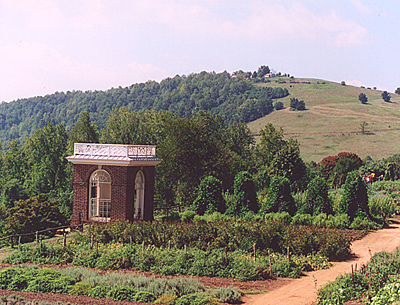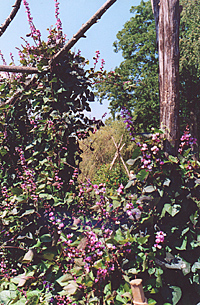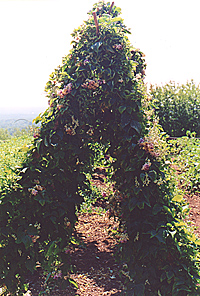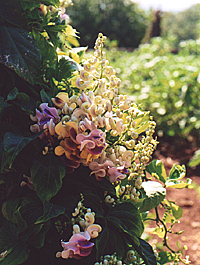 The Site
The Site
The vegetable garden evolved over many years, beginning in 1770 when crops were first cultivated along the contours of the slope. Terracing was introduced in 1806, and by 1812, gardening activity was at its peak. The 1,000-foot-long terrace, or garden plateau, was literally hewed from the side of the mountain with slave labor, and it was supported by a massive stone wall (1) that stood over twelve feet in its highest section. One contemporary visitor described it as a "hanging garden' while another remarked on the dramatic "sea view" across the rolling Piedmont countryside.
Roughly south of the house, the garden pavillion sits about halfway along the garden.
Perched atop the wall, at the half-way point of the garden, is the garden pavilion (2) with its double sash windows, Chinese railing, and pyramidal roof. The pavilion was used by Jefferson as a quiet retreat where he could read in the evening. It was reputedly blown down in a violent wind storm by the late 1820's. The pavilion was reconstructed in 1984 based on Jeffersons notes and archaeological excavations. It overlooks an eight-acre orchard of 300 trees, a vineyard, and Monticello's berry squares, which are plots of figs, currants, gooseberries, and raspberries.
The main part of the two-acre garden is divided into twenty-four "squares," or growing plots, and at least in 1812, the squares were arranged according to which part of the plant was being harvested -- whether "fruits" (tomatoes, beans), "roots" (beets, carrots), or "leaves" (lettuce, cabbage). Jefferson used the Northwest Border to plant peas very early in the season, and this should have provided a clear advantage in the annual neighborhood pea contests -- whoever brought the first English pea to table would host a dinner that included the winning dish of peas.
At the base of the wall, below the garden, Jefferson successfully grew figs in Submural Beds (3), which were also situated to create a uniquely warm setting. The site and situation of the garden enabled Jefferson to extend the growing season into the winter months and provided an amenable microclimate for tender vegetables such as the French artichoke (4).
The garden, as well as the orchard, was surrounded by a ten-foot-high, wooden or "paling" fence, which ran for nearly three-quarters of a mile. While the fence was constructed primarily as a defense against domestic animals and deer, the boards were placed "so near as not to let even a young hare in."
Jefferson - The Scientist
Thomas Jefferson was an astute observer of the natural world. The daily activities of sowing seeds, manuring asparagus (5), and harvesting peas between 1809 and 1826 are precisely recorded in his "Garden Kalendar," a part of his famous Garden Book. Jefferson was often the detached scientist in the Kalendar as he recorded that his Hotspur peas were "killed by frost Oct. 23," or that his yellow squash "came to nothing" in 1809. He also could record remarkable detail as in 1811 when he noted of his Asparagus beans that "2/3 pint sow a large square, rows 2 1/2 f. apart and 1 f. and 181. apart in the row, one half at each distance."
For Jefferson, the vegetable garden was a kind of laboratory where he could experiment with imported squashes and broccoli from Italy, beans and salsify collected by the Lewis and Clark expedition, figs from France, and peppers from Mexico. Although he would grow as many as twenty varieties of bean and fifteen types of English pea, his use of the scientific method selectively eliminated inferior types: "I am curious to select one or two of the best species or variety of every garden vegetable, and to reject all others from the garden to avoid the dangers of mixing or degeneracy."
 Jefferson - The Gardener
Jefferson - The Gardener
Although the garden was essentially a functional part of the plantation, Jefferson occasionally considered other ornamenta features aside from the garden pavilion. He discussed planting an arbor of different flowering shades of the scarlet runner bear (6), arranged adjacent rows of purple, white, and green sprouting broccoli, or even white and purple eggplant, and he borderec his tomato square with sesame or okra, a rather unusua juxtaposition of plant textures. Cherry trees were also plantec along the "long, grass walk" of the garden to provide shade (7)
- "I have lived temperately, eating little animal food, and that ... as a condiment for the vegetables, which constitute my principal diet."
Salads were an important part of Jeffersons diet. He would note the planting of lettuce and radishes every two weeks through the growing season, grow interesting greens such as orach, corn salad, endive, and nasturtiums, and yearly plant sesame in order to manufacture a palatable salad oil.
Although harvest has passed, some colorful flowers grace the vegetable garden.
Although the English pea is considered his favorite vegetable, he also cherished figs, asparagus, French artichokes, and such "new" vegetables as tomatoes, eggplant, broccoli, and cauliflower. While Jefferson cultivated more common vegetables such as cucumbers, beans (both "snaps" for fresh use and "haricots" that were dried), and cabbages, he also prized his sea kale (Crambe maritima), a perennial cabbage-like vegetable whose spring sprouts were blanched with clay pots, then cut and prepared like asparagus.
Cultivation Techniques
A major influence on Jefferson's gardening practices was Bernard McMahon, a Philadelphia nurseryman and author of The American Gardener's Calendar, the most complete American work on horticulture in the first half of the nineteenth century. McMahon's book provides directions for manuring the garden, interplanting lettuce and radishes, cultivating unusual vegetables such as tomatoes and sea kale, and planting cucumbers in hogsheads. These practices were duplicated carefully in the garden at Monticello. McMahon also sent Jefferson important vegetable varieties such as the Leadman's Dwarf pea, the Egyptian onion, Early York and Sugarloaf cabbage, red celery, and red globe artichoke.
In 1793 Martha Randolph wrote her father from Monticello and complained of insect damage in the garden. Jefferson's response summarized a basic philosophy of gardening:
- "We will try this winter to cover our garden with a heavy coating of manure. When earth is rich it bids defiance to droughts, yields in abundance, and of the best quality. I suspect that the insects which have harassed you have been encouraged by the feebleness of your plants; and that has been produced by the lean state of the soil. We will attack them another year with joint efforts."
 The Garden Today
The Garden Today
The recreation of the Monticello vegetable garden began in 1979 with two years of archaeological excavations that attempted to confirm details of the documentary evidence. Archaeologists uncovered the remnants of the stone wall, robbed in the twentieth century and covered by eroding soil, exposed the foundation of the garden pavilion, and searched for the nature of garden walkways. The ensuing recreation is especially accurate in detailing the structure of the garden -- the location of the garden squares, the site and character of the wall, and the appearance of the garden pavilion.
The garden recreation attempts to show, as best as possible, the garden as it existed between 1807 and 1814, to reveal Jefferson's experiments in horticulture and landscaping, and to serve as a site for the collection of both Jefferson and nineteenth-century vegetable varieties. The garden today, however, is only an interpretation of the original. Modern tools, such as roto-tillers, are utilized to ease the maintenance of the garden. Organic fertilizers, natural pesticides, and irrigation are used to preserve the varietal collection. Nineteenth-century techniques -- the use of brush for the staking of peas, the manuring of perennial vegetables, the construction of composted hills for squashes, melons, and beans -- are utilized when appropriate.
There are a number of differences between the appearance of the original Jefferson garden and the recreated one. In 1811, the most intensive planting year for Jefferson, there were eightyfive plantings of vegetables throughout the year. Today, the garden is planted much more intensively, partly for seed collection, partly to present a fuller interpretive picture. The rows of vegetables Jefferson planted were much closer together than they are portrayed today, the wider spacing a maintenance necessity. Although Jefferson alluded to the "long, grass walk," the nature of the internal pathways -- whether turf, gravel, tan bark, or more likely, packed earth -- is a matter of conjecture.
The low locust railing along the edge of the garden serves as a safety barrier. It is possible, however, to replant many of the perennials in the precise locations that Jefferson had specified. The figs along the Submural Beds, the cherry trees along the long grass walk, and the asparagus and artichoke squares conform precisely to their locations in the original garden. Also, many of the varieties Jefferson especially treasured, from the Marseilles fig to the Chile strawberry to the Tennis-ball lettuce, have been replanted in today's garden.
 Nineteenth-century Vegetables
Nineteenth-century Vegetables
The character of garden vegetables has been altered since the early 1800's due to the technology of commercial production, the tastes of the consumer public, and even the function of the vegetable itself. Some of the variations that distinguish modern varieties from their nineteenth-century parents include insect and disease resistance, a fruit suitable for shipping, compact plants, more consistent harvesting dates, and more cosmetically pleasing fruits. Most vegetable species are annuals and thus are lost easily if seed collection is neglected. Names have been changed for commercial purposes. Jefferson often listed varieties according to the person from whom he received the seed ("Leitch's pea"), its place of origin ("Tuscan bean"), or else he noted a physical characteristic such as color ("yellow carrot") or season of harvest ("Forward pea"). "Leitch's pea" is not only unavailable from commercial sources today, but there is no description of its qualities in the garden literature of the last two centuries. The collection of Jefferson's 250 vegetable varieties is a complex challenge. In many cases, the varieties planted in the garden today were known in the nineteenth century, and serve as substitutes for the originals grown by Jefferson.
Facts and Figures
Visitors are often surprised by the red color of the clay soil in the garden. Technically, it is a Davidson clay; the reddish color a result of the soil's high iron content. Soil amendments, such as compost, rotted leaves, or manure, are added at least once a year to improve drainage and promote greater fertility.
A full-time Vegetable Gardener, aided by summer assistants, cares for the garden, which is often planted three times a year -- for spring, summer, and fall harvests. These vegetables are distributed to Monticello employees. In many cases, in order to preserve a rare variety, plants are left to set seed, which is collected, sometimes distributed to other historic sites, but always saved for the next season.
Herbs, such as rosemary or thyme, are often cut for drying in the kitchen. Jefferson s central reference to them was a list of sixteen medicinal, fragrant, and culinary herbs in 1794; however, by 1814 he would write that "[my] garden is so bare of kitchen herbs, as to have but a single plant of sage, & that stripped of all its leaves." Herbs are distributed randomly throughout the garden rather than in a formal, isolated "herb garden."
The Thomas Jefferson Center For Historic Plants
Herb plants and perennial vegetables, as well as a full selection of heirloom seeds and books on the history of American gardening, are available at the Garden Shop which is located in the yellow and white striped tent at the Monticello Shuttle Station from April through October. The Thomas Jefferson Center for Historic Plants is devoted to the preservation and distribution of plants known in early American gardens.
More Monticello
Back to List of Historic Sites
Back to Travel Master List
Back to MagWeb Master List of Magazines
© Copyright 2003 by Coalition Web, Inc.
This article appears in MagWeb (Magazine Web) on the Internet World Wide Web.
Other articles covering military history and related topics are available at http://www.magweb.com